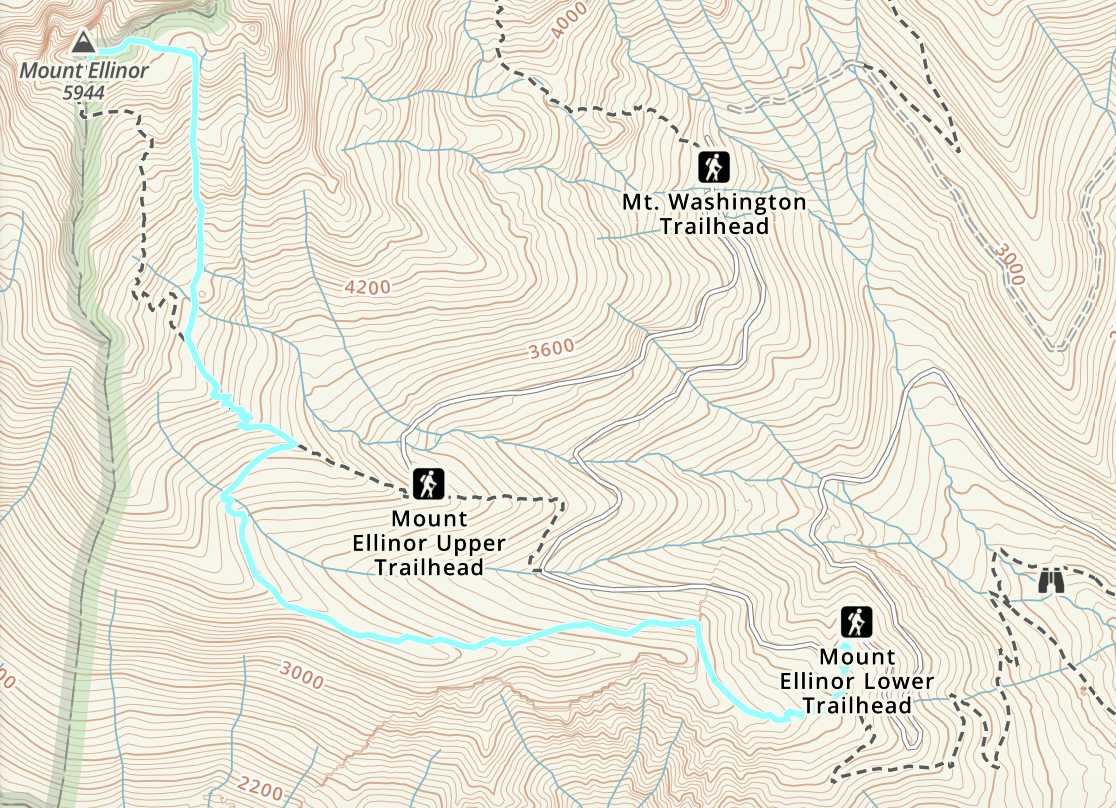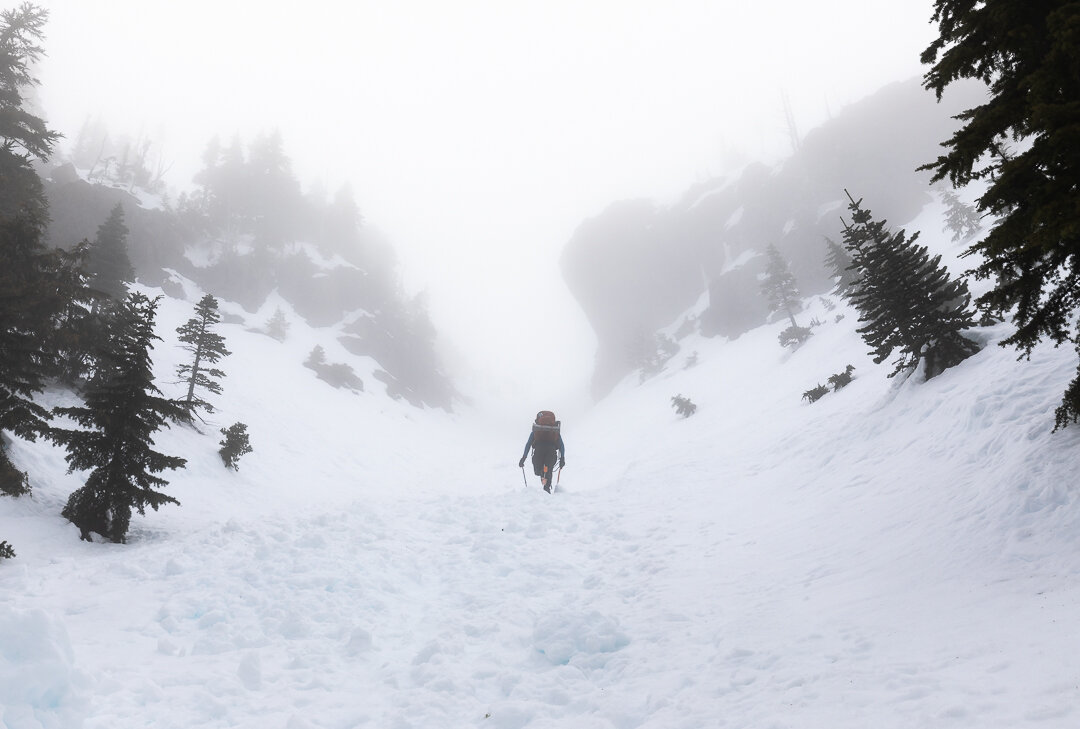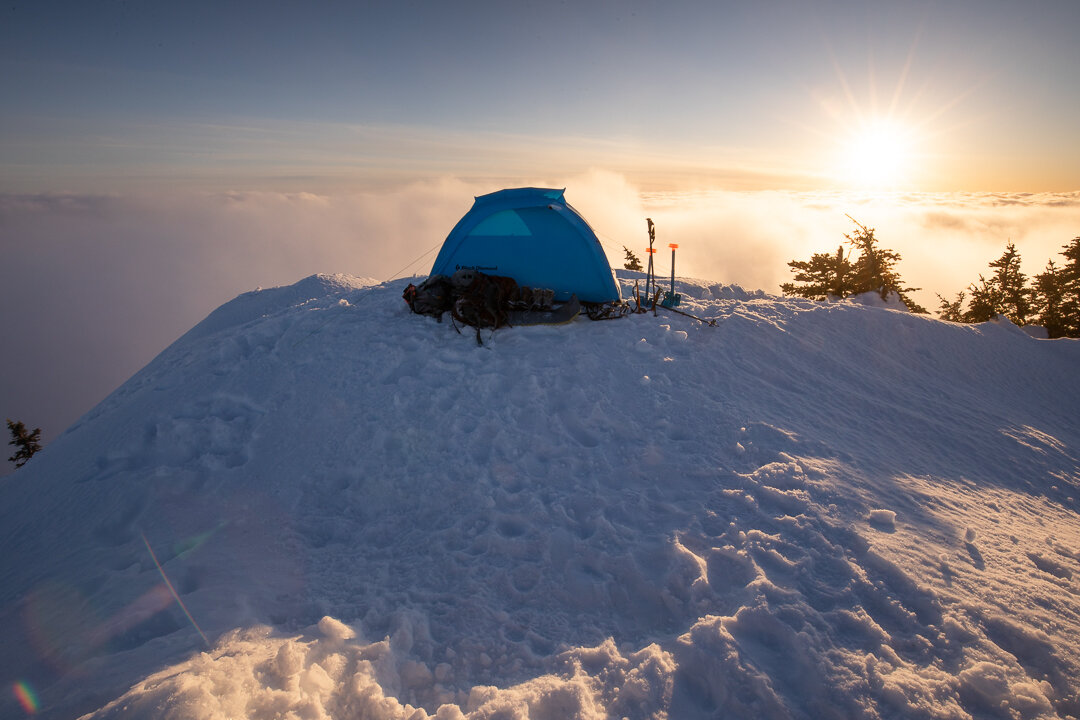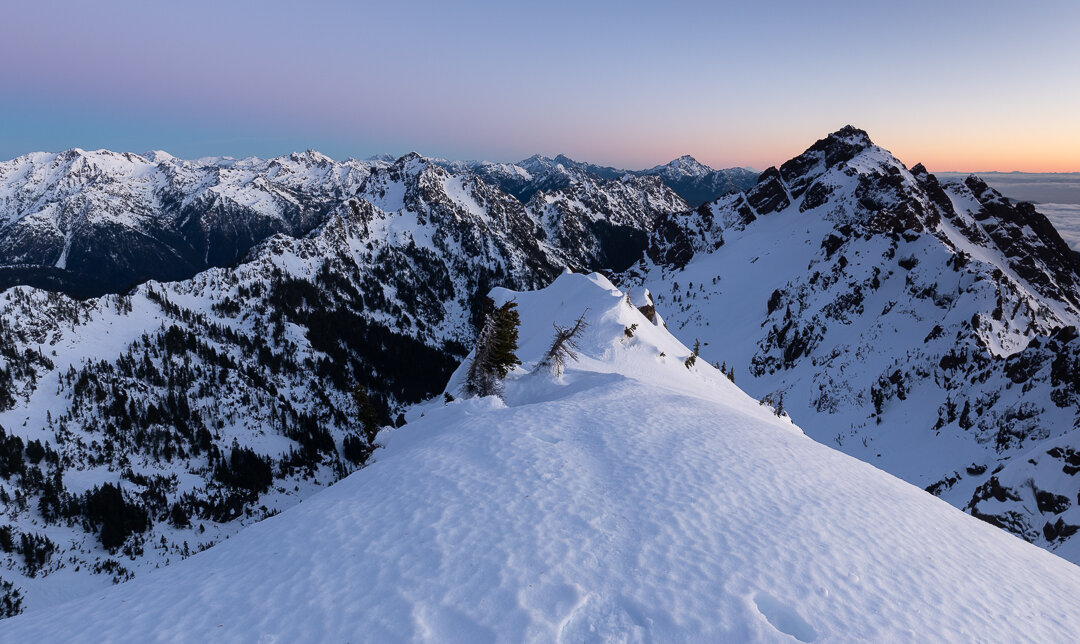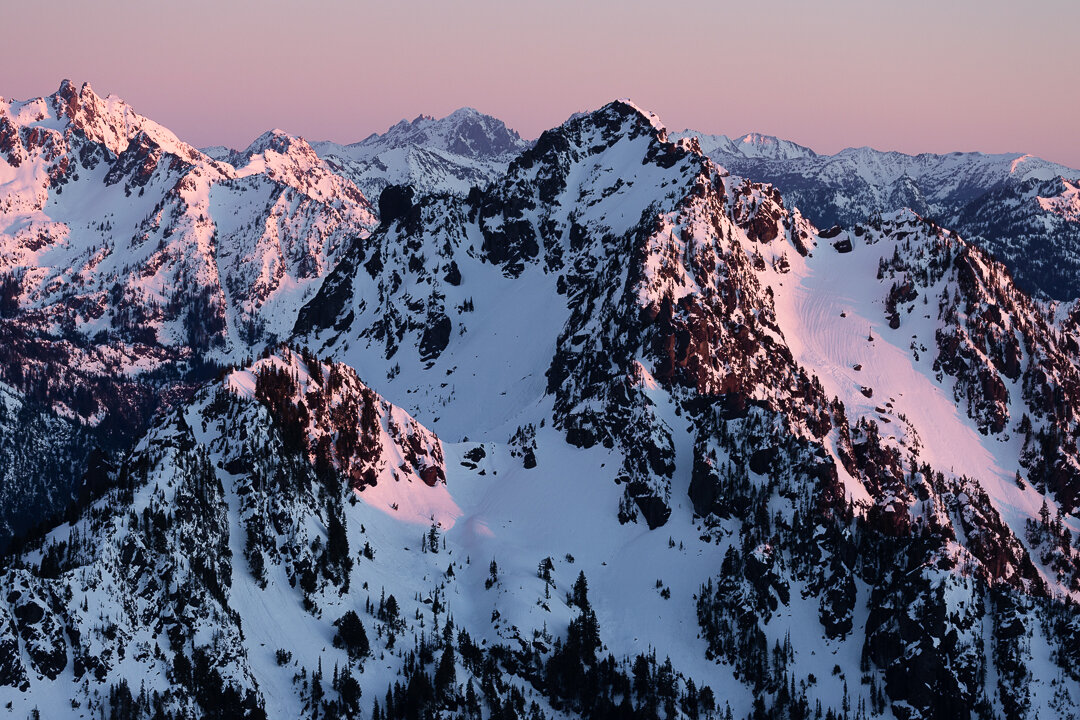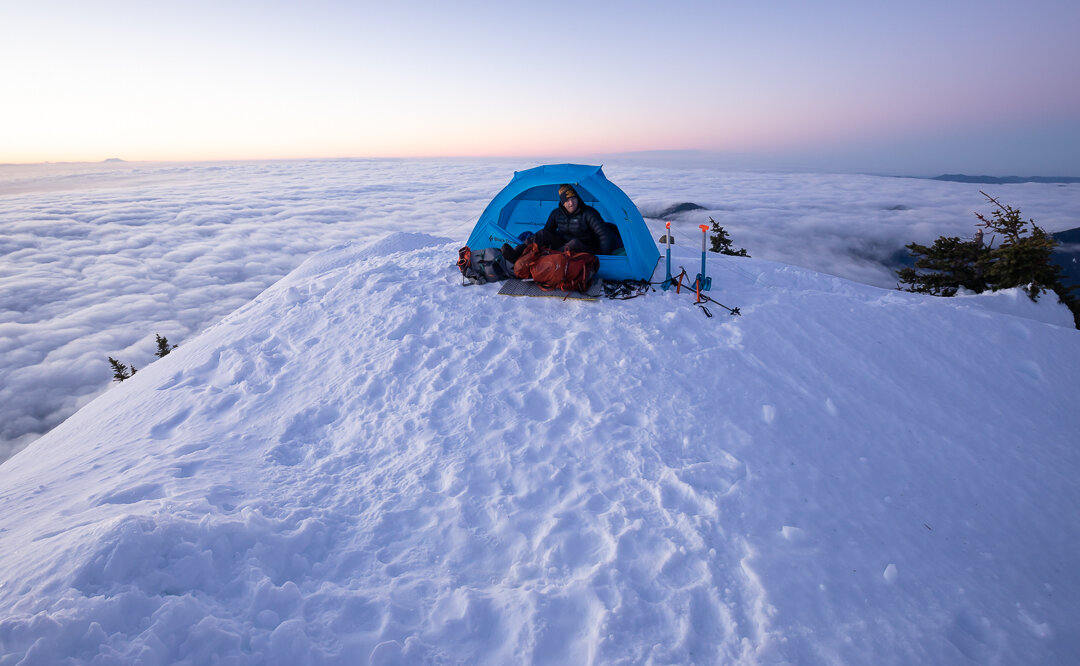First Backpacking Trip of 2021: Winter Summit of Mt. Ellinor
Dates Hiked: 1/17/21-1/18/21
On January 17, Alex and I headed to Olympic National Forest to venture out on our first backpacking trip of 2021. We hadn’t been backpacking since early September and were eager to spend a night under the stars again. We didn’t plan on going so long between trips, in fact, this 4.5 month stretch might be the longest we’ve gone without backpacking since we started backpacking in 2015! However, poor weather conditions, moving to a new home, and other personal obligations piled up and our trips kept getting postponed and cancelled.
The weather forecast was looking favorable, so we decided to head to Mt. Ellinor for a winter backpacking trip. We visited Mt. Ellinor for the first time in 2019 for a summit sunrise mission. The views from the summit blew me away and since that morning Alex and I planned to eventually return to spend a night in the area. The conditions finally seemed good enough to give it a shot.
The hike to Mt. Ellinor’s summit from the lower trailhead (the farthest our sedan could safely make it up the forest road) is around 3 miles and requires approximately 3,300’ of elevation gain, ~1,000’ of which is a steep climb up an avalanche chute. The snowy winter conditions would also necessitate bringing all of our avalanche gear and crampons, ice axes, and helmets to ensure we had the proper gear for the chute.
The view from Mt. Ellinor’s summit, looking into the basin below
We pulled into the gravel pullout that designated the lower trailhead at around 9AM and found the lot completely empty. We wanted to get an early start to ensure we were out of the avalanche chute before the sun really started to warm up the snow. We also didn’t bring snowshoes because we always try to avoid using them if we can (too big, heavy, cumbersome), so we didn’t want to have to worry about postholing either.
We pulled our packs out of the trunk, made sure we had all of our gear accounted for (yet not all of our gear was truly accounted for, a fact we would find out much later), and then began to hike up the trail through a quiet forest. The snow line had not crept down to the lower trailhead yet, so we made quick time along the misty trail.
At 3,400’ we hit consistent snow and pulled out our microspikes and continued up, up, up along the trail. The hike proved to be a real glute burner, but we were looking forward to a good conditioning hike as much as we were looking forward to spending some much-needed time in nature.
Alex heading up the avalanche chute
When we reached the bottom of the avalanche chute we traded out our microspikes for crampons, donned our helmets, picked up our ice axes, and turned on our avalanche beacons. The chute was full of debris from a recent slide. We knew we would encounter the debris because a few recent trip reports informed us as much. The debris had long since solidified into chunks of ice that resembled the texture of a giant’s version of frozen cottage cheese and made navigating up the chute even trickier. As we made our way up, the visibility deteriorated. Clouds hung low in the sky, clung to the mountains, and kept the ground icy. There was one group ahead of us in the chute, we tried to keep an eye on them, but they were quickly swallowed up by the mist.
Each step in the chute required careful consideration. I gripped my ice firmly, ready to self-arrest in case of a slip. Thankfully, I didn’t slip. Eventually, we broke out of the first portion of the chute into a (relatively) flat section for a break. We could finally see the depression in the ridge above us that indicated the end of the avalanche chute. This would spit us out into a sprawling basin where we hoped to find a spot to camp for the evening.
Finally in the basin and the clouds are starting to dissipate
We took a quick water break before finally exiting the avalanche chute. The visibility was still poor, but it seemed as if the clouds were thinning and we could see gaps of blue between the walls of white. We relished in the break from the mental and physical challenge of climbing up the steep and icy slopes of the avalanche chute and stopped on a hill to eat lunch and assess our plan for the rest of the day. We had anticipated sleeping in the basin but as we looked around we couldn’t find many spots that looked flat that weren’t pure ice or nestled at the base of an avalanche slope.
We heard a few groups heading down from the summit and, like mirages, they appeared out of the clouds not too much farther in front of our lunch spot. They stopped to chat and let us know that we were sitting right at cloud level and that just a couple hundred feet above us—on the summit—the views were clear and beautiful. We thanked them for the encouragement and continued our climb with a new plan to sleep on the ledge above the basin.
Another steep climb brought us above the clouds. On our previous visit I remember the area above the basin being much flatter, but this time the ridge was full of windswept hills and bulletproof ice. There didn’t appear to be any decent place to set up camp. We dropped our packs on the ice and sat down.
As I sat on my pack, feeling dejected and tired, I looked up at the summit just above us. I mulled over the idea of a summit bivy. It wasn’t something we had considered while planning this trip but the summit was sitting in the sun all afternoon so its snow would likely be much more pliable than the ice we had found everywhere else. I hurried up the slope, sans pack, and found myself on the summit. To my excitement, there were two flat areas, already the perfect size of a tent, on top of the mountain. I called down to Alex, “I think this is it!”
It was going to be the most “you did not sleep there” spot we’ve possibly ever camped, but the snow was nice, the ground was flat, and the views were phenomenal—360 degrees of stunning mountain views from the lofty perch. I ran back down to grab my pack and Alex and I headed to the summit together.
Alex making the final few steps to the summit of Mt. Ellinor
By the time we were both on the summit it was early afternoon but the sun was already low in the sky. We hadn’t seen any groups since we exited the avalanche chute and saw a couple groups coming down. Sunset was fast approaching and it didn’t seem likely any more groups would be coming up so late in the day, with the icy, avalanche debris-filled chute to navigate in the dark. We set up our tent and took in the views around us. Mt. Washington dominated the sky to the northeast, and to the northwest and west was a sea of peaks in the Olympics, with Mt. Olympus in the distance.
Our tent on the summit
We decided to make an early dinner so we could spend all of sunset taking photos and just enjoying the scene. This was when I made a disappointing discovery: I forgot to pack a lighter and matches. We had always kept a lighter in our first aid kit, but sometime in the previous months that lighter went missing, unbeknownst to us. We would not be able to boil water to make dinner or breakfast or coffee. We would also not be able to melt snow to filter more water (luckily, we had packed enough and wouldn’t need more water). I felt so defeated. I was looking forward to cuddling the pack of rehydrating food and then eating a hearty meal that would warm me from the inside out. Instead, we were forced to split a Clif bar, a Kind bar, and a pack of nuts for dinner and breakfast between the two of us. Hardly enough calories after the strenuous hike we just completed!
Sunset light on Mt. Washington, seen from the summit of Mt. Ellinor
While dinner was a disappointment, the sunset that followed was anything but. The clouds that had been rolling around us all afternoon began to sink beneath the peaks, creating an illusion that the mountains were islands floating on a pillowy sea. The clouds began to turn golden yellow, then orange, and finally the softest shades of pink and purple. This pastel color palette that paints the sky during blue hour are my favorite hues to see in nature!
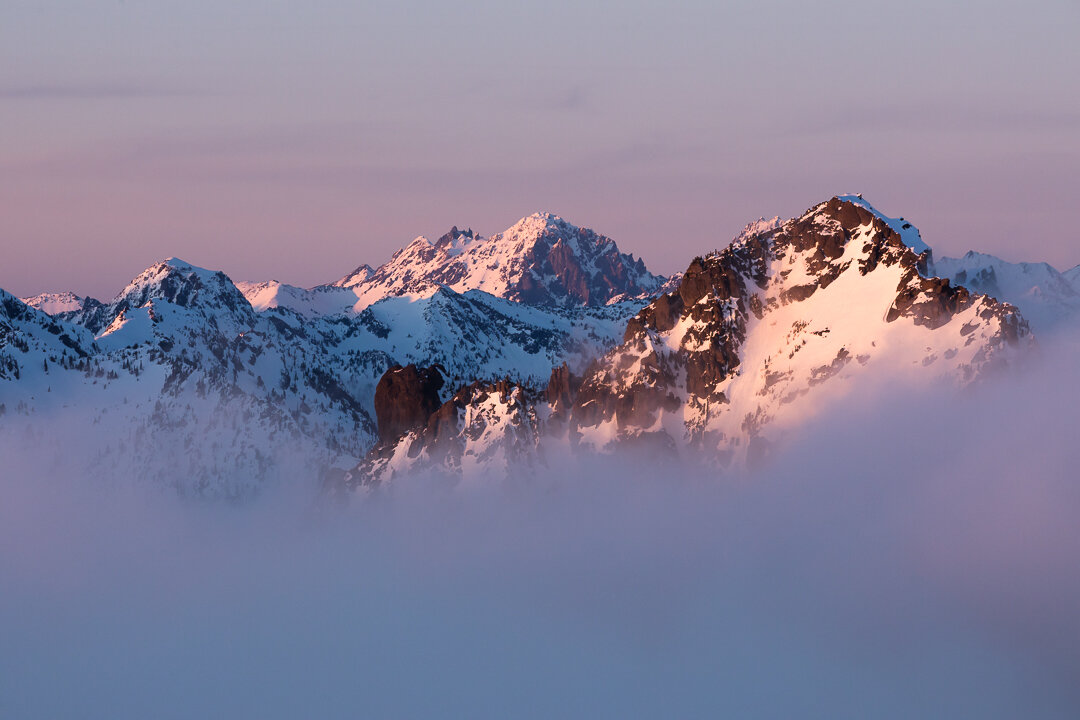
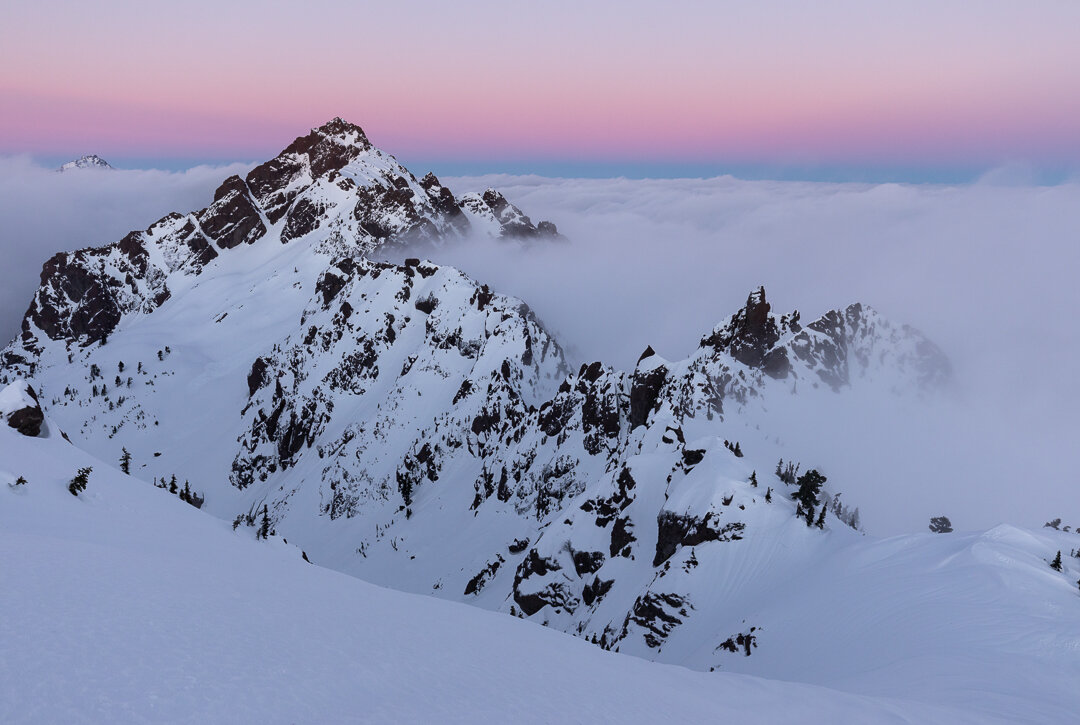
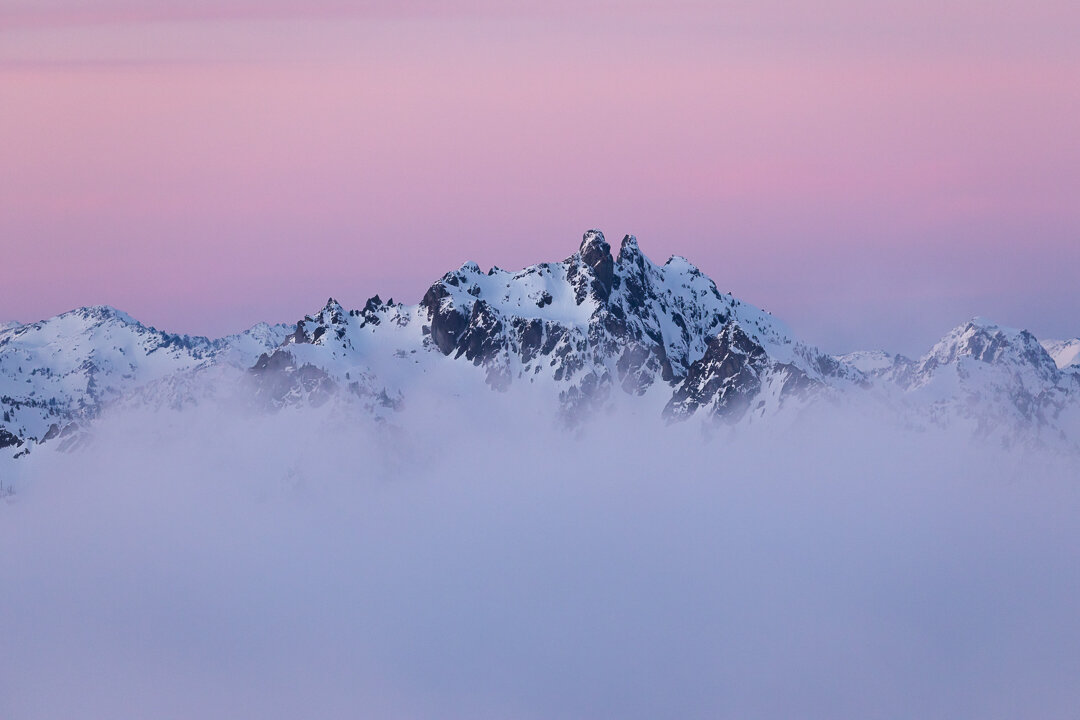
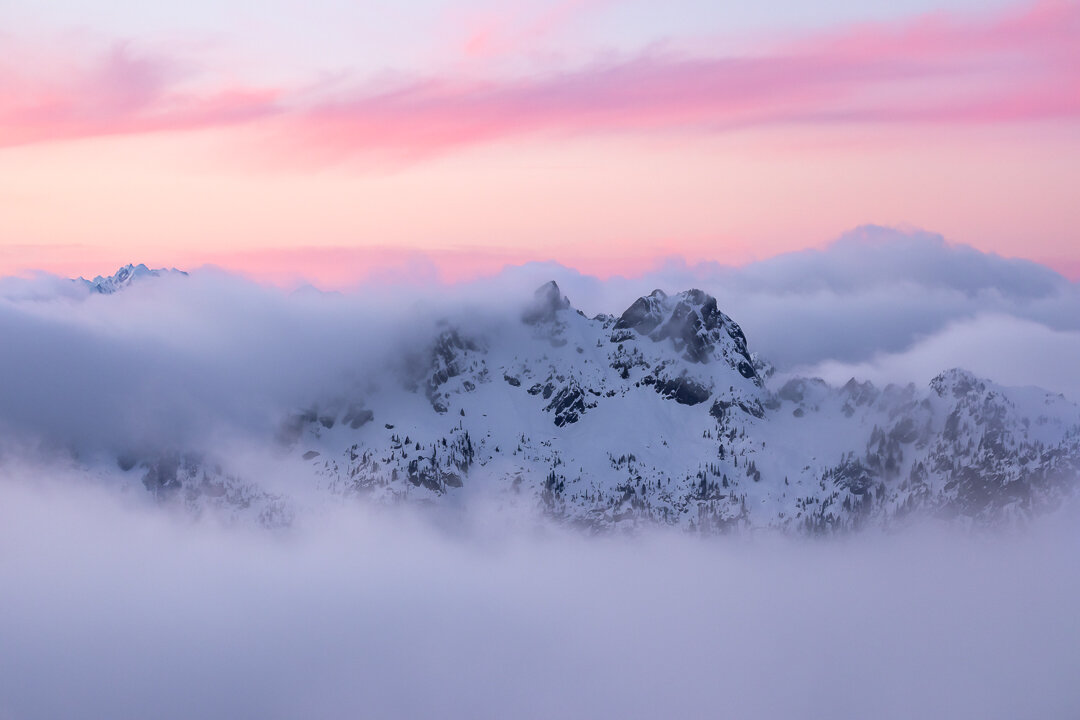
Finally, when the last colors faded from the sky and the wind nipped just a little too harshly at our noses, we retreated to the tent for the evening. For 14 hours. One of my least favorite parts of winter camping is the never-ending nights that keep me tent-bound, trying to force myself to sleep for far longer than even the most physically exhausting trip would require.
Early morning views
Mt. Rainier sitting atop a sea of clouds at sunrise
After a long night, I awoke well before my alarm and peered out the tent’s meshy window. The eastern horizon was just beginning to glow. I could see the colossal silhouette of Mt. Rainier even during the barely-there dawn. I lay cozy in my sleeping bag, patiently waiting for Nautical twilight to transition to blue hour. Finally, the stars disappeared into the light and the mountain faces became more detailed. I bundled up and headed out into the cold. The scene that was unfolding right outside of our door was stunning. To the east a pool of clouds seemed to have been blocked by the mountain range and caught beneath their peaks. To the west and north were crisp, clear views of the Olympics. The sunrise that followed was just as spectacular as the sunset that preceded it. The bands of Venus glowed pink, and eventually the first light of day painted the snowy mountain faces in a vibrant pink.
A few minutes before sunrise, a lone hiker climbed the final few feet to the summit and joined us just in time to watch the sun crest the horizon over Mt. Rainier’s arm. We stood in awe, and finally felt the sun kiss our faces after a long, cold night.
First light, with Mt. Rainier and Mt. Adams in the distance
Alex beginning the descent down the avalanche chute
After sunrise we packed up quickly, eager to get back on the trail (and to food). The descent from the summit was immediately precarious. The steep slope was still frozen in the early morning so we had to carefully down-climb from the summit. We had hoped that the sun would begin to cook the snow so we could plunge step—that is, to use gravity and our bodyweight to get solid footholds in snow on steep slopes. However, the stubborn snow was still refusing to yield to our feet, so we had to carefully navigate each step down, kicking into the side of the slope with our crampons to gain purchase in the solid snow. This made the going down much more difficult (both physically and mentally) than the hike up. A single misstep could have sent us careening down the icy slopes, but we made our way down and rejoiced when we could finally made it to the bottom of the chute. The hardest part was over! All we had left was a couple mile hike back to the car through a beautiful forest.
The miles passed by quickly and before noon we were back at the car, feeling relieved to finally take off our boots and slip into more comfortable shoes. The trailhead that we had left so empty the previous day was now full of cars (and we had passed quite a few people making their way up as we headed down). We were so grateful to have spent a beautiful night on the summit of Mt. Ellinor for our first backpacking trip of 2021. It wasn’t what we had planned, and we may have had to forgot a warm dinner, but I’m so grateful for the sunset and sunrise we were able to witness from our camp.
Misty views in the forest on the hike back to the car


